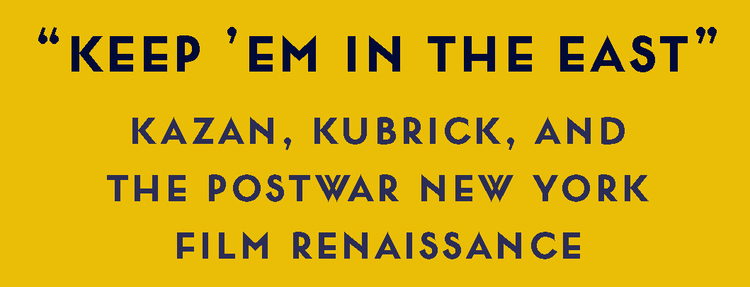
Ironically, some of the greatest films from the so-called New Hollywood era (The Godfather, The French Connection, Annie Hall) were made on location in New York rather than in Los Angeles. New York City established a film commission in 1966 (the first in the country), leading to an immediate and dramatic increase in film production, which has since become known as the New York film renaissance. Richard Koszarski’s Keep ’em in the East: Kazan, Kubrick, and the Postwar New York Film Renaissance offers a revisionist history of the 1940s and ’50s New York film scene, arguing that the roots of the renaissance stretch back long before 1966.
Koszarski discusses the documentary-like police procedural thrillers filmed on the streets of New York (The House on 92nd Street, The Naked City, Boomerang!), demonstrating that, although this style evolved alongside Neo-Realism, it was not directly influenced by Italian cinema. Only one Neo-Realist film, Rome, Open City (Roma cittá aperta), had been released in the US during the peak period of the New York docu-dramas, thus their similar modes of production were largely coincidental.
The book’s final chapters alternate between the production histories of Elia Kazan’s On the Waterfront and Stanley Kubrick’s Killer’s Kiss, which (incredibly) were among only three films made in New York in the winter of 1953 (the other being Hansel and Gretel). Interestingly, he reveals that Killer’s Kiss (under its original title, Kiss Me, Kill Me) was censored by four minutes by the MPAA, and that a further three minutes were cut by either Kubrick or the film’s distributor, United Artists, before its theatrical release.
Koszarski discusses the documentary-like police procedural thrillers filmed on the streets of New York (The House on 92nd Street, The Naked City, Boomerang!), demonstrating that, although this style evolved alongside Neo-Realism, it was not directly influenced by Italian cinema. Only one Neo-Realist film, Rome, Open City (Roma cittá aperta), had been released in the US during the peak period of the New York docu-dramas, thus their similar modes of production were largely coincidental.
The book’s final chapters alternate between the production histories of Elia Kazan’s On the Waterfront and Stanley Kubrick’s Killer’s Kiss, which (incredibly) were among only three films made in New York in the winter of 1953 (the other being Hansel and Gretel). Interestingly, he reveals that Killer’s Kiss (under its original title, Kiss Me, Kill Me) was censored by four minutes by the MPAA, and that a further three minutes were cut by either Kubrick or the film’s distributor, United Artists, before its theatrical release.


